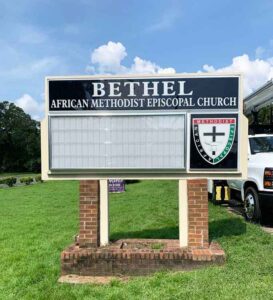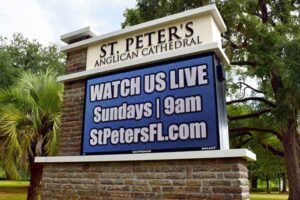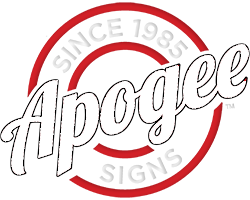 Explore the ever-changing realm of church signage, where tradition intersects with technology. This article delves into the distinctions between traditional and modern church signs, with traditional signs embodying timeless elegance through classic designs and fixed messages, while their modern counterparts embrace sleek aesthetics, dynamic content, and interactivity. Discover how these choices can impact your church’s visibility, engagement, and communication effectiveness, allowing you to make an informed decision that aligns with your church’s unique identity and outreach objectives.
Explore the ever-changing realm of church signage, where tradition intersects with technology. This article delves into the distinctions between traditional and modern church signs, with traditional signs embodying timeless elegance through classic designs and fixed messages, while their modern counterparts embrace sleek aesthetics, dynamic content, and interactivity. Discover how these choices can impact your church’s visibility, engagement, and communication effectiveness, allowing you to make an informed decision that aligns with your church’s unique identity and outreach objectives.
Traditional and modern church signs differ significantly in their design, messaging, and functionality, reflecting the evolving landscape of communication methods and styles over time. Here are key differences between the two:
Design and Aesthetics:
Traditional Church Sign: Traditional church signs often feature classic design elements such as wooden or stone structures adorned with meticulously carved lettering. They may incorporate crosses or religious symbols, maintaining a formal and conservative appearance.
Modern Church Sign: In contrast, modern church signs adopt a sleek and contemporary design approach, utilizing materials like aluminum, glass, or LED displays. These signs captivate with dynamic graphics, digital displays, and creative lighting, resulting in a visually appealing and attention-grabbing presentation.
Messaging:
Traditional Church Sign: Traditional signs typically convey static messages with fixed text or scripture verses. They may announce forthcoming events, showcase service times, or convey inspirational messages, but their content is typically confined to what can be physically printed or painted on the sign.
Modern Church Sign: Modern signs offer greater messaging flexibility thanks to digital displays and technology. They can rotate messages, exhibit multimedia content, and even connect to social media or websites for real-time updates on events, sermons, or other church activities.
 Interactivity:
Interactivity:
Traditional Church Sign: Traditional signs tend to be passive, serving as sources of information without facilitating direct engagement with the audience.
Modern Church Sign: Modern signs can incorporate interactive features such as touch screens, QR codes, or mobile app integration. These innovations empower visitors to access additional information, watch videos, or engage with the church community in novel ways.
Visibility and Impact:
Traditional Church Sign: Traditional signs, reliant on static content, may not capture the attention of passersby as effectively as modern signs. Their impact is confined to the information they can convey through text and basic visuals.
Modern Church Sign: Modern signs leverage dynamic content and enhanced visibility through LED displays boasting vibrant colors and engaging animations. This feature makes it easier for churches to effectively communicate their message to a broader audience.
Maintenance:
Traditional Church Sign: Traditional signs necessitate regular maintenance to preserve their appearance, which may include repainting, cleaning, or addressing physical damage.
Modern Church Sign: While modern signs may require periodic maintenance for electronic components, they typically offer a longer lifespan and are more straightforward to update with new content compared to traditional signs.
In summary, the primary distinction between traditional and modern church signs lies in their design, messaging capabilities, interactivity, visibility, and maintenance requirements. Modern church signs harness technology to provide dynamic and engaging communication, while traditional signs exude a classic and static charm. The choice between the two depends on a church’s preferences, budget, and communication goals.
